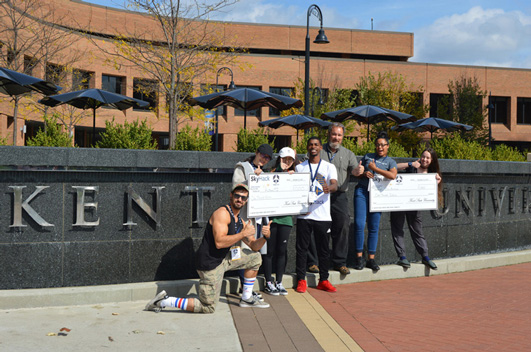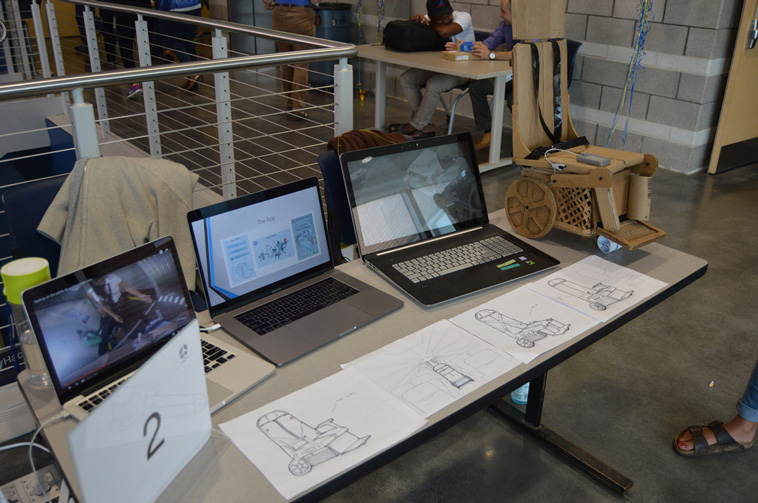CCAD students win big in aviation design challenge

CCAD students won big at the Sky Hack Aviation Hackathon at Kent State University. From left to right: Matthew Erdmann, Xin Xu, Hsiu-Wen Chang, Damyyan Eaford (who goes to school in Cleveland), David Burghy, Lakaya Fearon, and Jessika Raisor.
A group of students from Columbus College of Art & Design won big in an aviation design challenge hosted at Kent State University.
Two teams featuring students from CCAD’s Industrial Design and Animation programs won first place and $1,000 for their designs at the Sky Hack Aviation Hackathon Oct. 13 – 15, 2017.
More than 120 students from over 30 colleges converged at the Kent State College of Aeronautics and Engineering to participate in the 36-hour design marathon. Event sponsors introduced five challenges at the opening of the event. Students had one hour to formulate ideas and divide into teams of two to six students. The teams then had from 9 p.m. Friday until 9 a.m. Sunday to construct their ideas for a final presentation to panels of aviation professionals.
Lakaya Fearon (Industrial Design, 2021) and Jessika Raisor (Animation, 2019) teamed up to investigate developing a novel means of using sky-based or space-based platforms to augment, enhance, or rebuild the power and communications infrastructure in disaster-affected areas.
“Lakaya was particularly interested in this design challenge since she has experienced first-hand the problem of disaster relief communications,” said Professor of Industrial Design David Burghy, who mentored the group of CCAD students. “Her mother lives in Puerto Rico, and Lakaya waited over two weeks after the recent hurricane to find out if her mother was safe.”
Fearon and Raisor designed a solar- and bio-fuel-powered blimp that could be deployed from a transport aircraft after a natural disaster to create a temporary hovering communications hotspot. The blimps could be tethered together to create a net of hotspots covering an area and providing much needed communications after any type of natural disaster. When they are no longer needed, the blimps could be gathered, deflated, and stored for the next disaster.

Jessika Raisor, left, and Lakaya Fearon, right, present their ideas for bio-fuel-powered communications blimp.
CCAD Industrial Design students Matthew Erdmann (2021), Xin Xu (2019), and Hsiu-Wen Chang (2019) worked with a student from another school to create a smart wheelchair and app that could guide handicapped passengers through the airport, security points, help them get to their gate quickly, and actually be used within an aircraft so that the traveler would not have to be transferred from wheelchair to seat multiple times. Their research found that a traveler in a wheelchair currently averages 5 transfers from the chair per flight with 3-5 flight attendants required per transfer. Their design would reduce that number to 2 transfers with 1-2 flight attendants per transfer.

Autonomous Mobility and Information wheelchair presentation showing from left to right: video from research of problems involved with transporting a wheelchair within an aircraft; the app for easy navigation around the airport, wait times at TSA checkpoints, and flight information; the design process and drawings of final ideas; and a half-scale model of AutonoMI chair and smart device.
Each team took first place for their respective Design Innovation Challenge Streams and received a $1,000 check.
And they may be doing more with their designs.
“Both teams were contacted by professionals who offered to help make both design ideas a reality,” Burghy said. “So stay tuned.”
Learn more about CCAD’s Industrial Design and Animation programs.